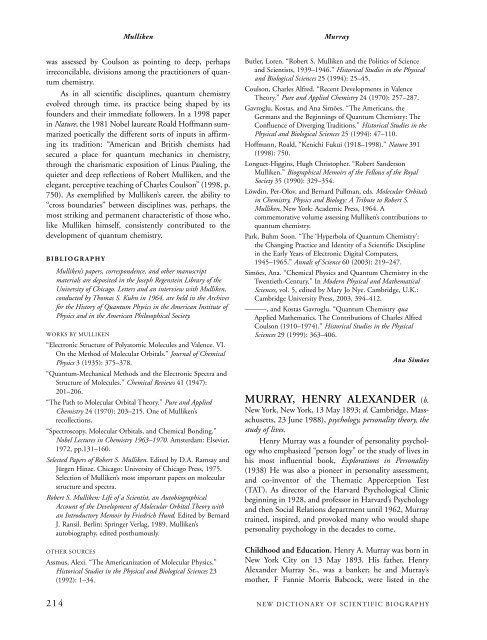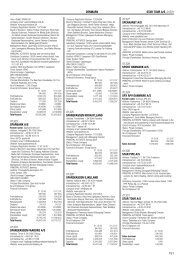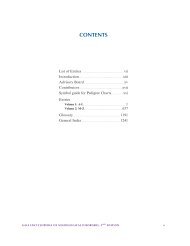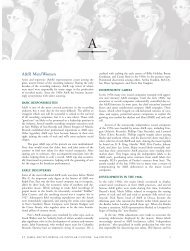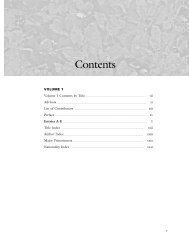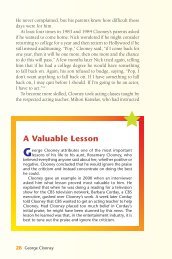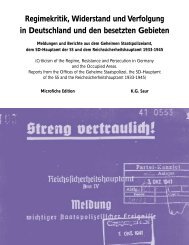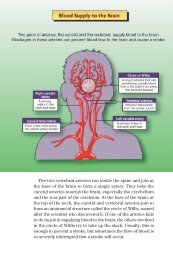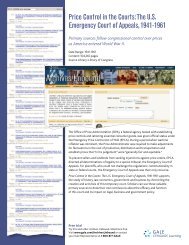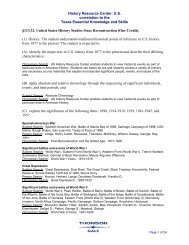MURRAY, HENRY ALEXANDER (b. - Gale
MURRAY, HENRY ALEXANDER (b. - Gale
MURRAY, HENRY ALEXANDER (b. - Gale
Create successful ePaper yourself
Turn your PDF publications into a flip-book with our unique Google optimized e-Paper software.
Mulliken<br />
Murray<br />
was assessed by Coulson as pointing to deep, perhaps<br />
irreconcilable, divisions among the practitioners of quantum<br />
chemistry.<br />
As in all scientific disciplines, quantum chemistry<br />
evolved through time, its practice being shaped by its<br />
founders and their immediate followers. In a 1998 paper<br />
in Nature, the 1981 Nobel laureate Roald Hoffmann summarized<br />
poetically the different sorts of inputs in affirming<br />
its tradition: “American and British chemists had<br />
secured a place for quantum mechanics in chemistry,<br />
through the charismatic exposition of Linus Pauling, the<br />
quieter and deep reflections of Robert Mulliken, and the<br />
elegant, perceptive teaching of Charles Coulson” (1998, p.<br />
750). As exemplified by Mulliken’s career, the ability to<br />
“cross boundaries” between disciplines was, perhaps, the<br />
most striking and permanent characteristic of those who,<br />
like Mulliken himself, consistently contributed to the<br />
development of quantum chemistry.<br />
BIBLIOGRAPHY<br />
Mulliken’s papers, correspondence, and other manuscript<br />
materials are deposited in the Joseph Regenstein Library of the<br />
University of Chicago. Letters and an interview with Mulliken,<br />
conducted by Thomas S. Kuhn in 1964, are held in the Archives<br />
for the History of Quantum Physics in the American Institute of<br />
Physics and in the American Philosophical Society.<br />
WORKS BY MULLIKEN<br />
“Electronic Structure of Polyatomic Molecules and Valence. VI.<br />
On the Method of Molecular Orbitals.” Journal of Chemical<br />
Physics 3 (1935): 375–378.<br />
“Quantum-Mechanical Methods and the Electronic Spectra and<br />
Structure of Molecules.” Chemical Reviews 41 (1947):<br />
201–206.<br />
“The Path to Molecular Orbital Theory.” Pure and Applied<br />
Chemistry 24 (1970): 203–215. One of Mulliken’s<br />
recollections.<br />
“Spectroscopy, Molecular Orbitals, and Chemical Bonding.”<br />
Nobel Lectures in Chemistry 1963–1970. Amsterdam: Elsevier,<br />
1972, pp.131–160.<br />
Selected Papers of Robert S. Mulliken. Edited by D.A. Ramsay and<br />
Jürgen Hinze. Chicago: University of Chicago Press, 1975.<br />
Selection of Mulliken’s most important papers on molecular<br />
structure and spectra.<br />
Robert S. Mulliken: Life of a Scientist, an Autobiographical<br />
Account of the Development of Molecular Orbital Theory with<br />
an Introductory Memoir by Friedrich Hund. Edited by Bernard<br />
J. Ransil. Berlin: Springer Verlag, 1989. Mulliken’s<br />
autobiography, edited posthumously.<br />
OTHER SOURCES<br />
Assmus, Alexi. “The Americanization of Molecular Physics.”<br />
Historical Studies in the Physical and Biological Sciences 23<br />
(1992): 1–34.<br />
Butler, Loren. “Robert S. Mulliken and the Politics of Science<br />
and Scientists, 1939–1946.” Historical Studies in the Physical<br />
and Biological Sciences 25 (1994): 25–45.<br />
Coulson, Charles Alfred. “Recent Developments in Valence<br />
Theory.” Pure and Applied Chemistry 24 (1970): 257–287.<br />
Gavroglu, Kostas, and Ana Simões. “The Americans, the<br />
Germans and the Beginnings of Quantum Chemistry: The<br />
Confluence of Diverging Traditions.” Historical Studies in the<br />
Physical and Biological Sciences 25 (1994): 47–110.<br />
Hoffmann, Roald, “Kenichi Fukui (1918–1998).” Nature 391<br />
(1998): 750.<br />
Longuet-Higgins, Hugh Christopher. “Robert Sanderson<br />
Mulliken.” Biographical Memoirs of the Fellows of the Royal<br />
Society 35 (1990): 329–354.<br />
Löwdin, Per-Olov, and Bernard Pullman, eds. Molecular Orbitals<br />
in Chemistry, Physics and Biology: A Tribute to Robert S.<br />
Mulliken. New York: Academic Press, 1964. A<br />
commemorative volume assessing Mulliken’s contributions to<br />
quantum chemistry.<br />
Park, Buhm Soon. “The ‘Hyperbola of Quantum Chemistry’:<br />
the Changing Practice and Identity of a Scientific Discipline<br />
in the Early Years of Electronic Digital Computers,<br />
1945–1965.” Annals of Science 60 (2003): 219–247.<br />
Simões, Ana. “Chemical Physics and Quantum Chemistry in the<br />
Twentieth-Century.” In Modern Physical and Mathematical<br />
Sciences, vol. 5, edited by Mary Jo Nye. Cambridge, U.K.:<br />
Cambridge University Press, 2003, 394–412.<br />
———, and Kostas Gavroglu. “Quantum Chemistry qua<br />
Applied Mathematics. The Contributions of Charles Alfred<br />
Coulson (1910–1974).” Historical Studies in the Physical<br />
Sciences 29 (1999): 363–406.<br />
Ana Simões<br />
<strong>MURRAY</strong>, <strong>HENRY</strong> <strong>ALEXANDER</strong> (b.<br />
New York, New York, 13 May 1893; d. Cambridge, Massachusetts,<br />
23 June 1988), psychology, personality theory, the<br />
study of lives.<br />
Henry Murray was a founder of personality psychology<br />
who emphasized “person logy” or the study of lives in<br />
his most influential book, Explorations in Personality<br />
(1938) He was also a pioneer in personality assessment,<br />
and co-inventor of the Thematic Apperception Test<br />
(TAT). As director of the Harvard Psychological Clinic<br />
beginning in 1928, and professor in Harvard’s Psychology<br />
and then Social Relations department until 1962, Murray<br />
trained, inspired, and provoked many who would shape<br />
personality psychology in the decades to come.<br />
Childhood and Education. Henry A. Murray was born in<br />
New York City on 13 May 1893. His father, Henry<br />
Alexander Murray Sr., was a banker; he and Murray’s<br />
mother, F Fannie Morris Babcock, were listed in the<br />
214 NEW DICTIONARY OF SCIENTIFIC BIOGRAPHY
Murray<br />
Murray<br />
Social Register. Their early houses were just off Fifth<br />
Avenue on West 49th and West 51st Streets, and were<br />
demolished in the 1930s to make way for Rockefeller<br />
Center. Murray described his childhood in his autobiography<br />
as that of “the average, privileged American boy.”<br />
Murray had warm relations with his father, and thus<br />
did not personally resonate to Sigmund Freud’s account of<br />
Oedipal hostilities of a boy toward his father. Murray was<br />
the middle of three children, with an older sister, Virginia,<br />
born in 1890 and a younger brother, nicknamed “Mike,”<br />
born in 1897. Murray felt that his mother favored his<br />
older sister and younger brother, and as a child he came to<br />
“the grievous (and valid) realization that he could count<br />
on only a third-best portion of his mother’s love” (1967,<br />
p. 298) This left him with a “marrow of misery and<br />
melancholy” that he suggests sensitized him to the sufferings<br />
of others, particularly women, and may have influenced<br />
his later career choices of medicine and<br />
psychotherapy. This underlying melancholy was<br />
“repressed by pride and practically extinguished in everyday<br />
life by a counteracting disposition of sanguine and<br />
expansive buoyancy,” yet he was left with “an affinity for<br />
the darker, blinder strata of feeling,” which drew him to<br />
tragic themes in literature and psychology. In psychology,<br />
his interest was not in the psychophysics of perception,<br />
but in following a “bent of curiosity toward all profound<br />
experiences of individual men and women” (Murray, 1981<br />
[1959], p. 8).<br />
Murray attended prep school at Groton and then<br />
Harvard College from 1911 to 1915. He majored in history<br />
but was not a diligent student, and was proudest of<br />
being the captain of the Harvard crew team. He was also<br />
active in many social organizations, elected during his<br />
junior year to lead the Phillips Brooks House Association,<br />
a social service organization for Harvard students. His<br />
only exposure to psychology in college was two lectures by<br />
Hugo Munsterberg on the senses, which sent him looking<br />
for the nearest exit. He later joked to his biographer in<br />
1970 that he had “majored in the three Rs—Rum, Rowing,<br />
and Romanticism” (Robinson, 1992, p. 27).<br />
The day after the final crew race against Yale, Murray<br />
became engaged to Josephine Rantoul, an attractive, outgoing<br />
woman from an upper-class Boston family, with an<br />
interest in social service. They were married in 1916 and<br />
lived together until her death in 1962; they had one<br />
daughter, Josephine, born in 1921, who later became a<br />
physician. Intellectually, Murray came alive in medical<br />
school at the Columbia College of Physicians and Surgeons,<br />
graduating at the top of his class with a medical<br />
degree in January 1919. Murray wanted to pursue the<br />
underlying sciences in more depth, so he obtained a master’s<br />
degree in biology at Columbia in 1920, and a PhD in<br />
physiological chemistry from Cambridge University in<br />
1927. He began a surgical internship at Presbyterian Hospital<br />
in New York City in the fall of 1920. Paul Robeson<br />
came into Presbyterian on a stretcher with a torn thigh<br />
muscle from football. Murray assisted in the surgery, and<br />
was assigned to look after the patient. Murray introduced<br />
him to a woman in the pathology lab, Essie Cardozo<br />
Goode, whom Robeson soon married. Murray and his<br />
wife stayed friends with the Robesons for years; attended<br />
Robeson’s performances in Emperor Jones, All God’s Children,<br />
and Othello; and held receptions for them at their<br />
home.<br />
In 1921 Franklin D. Roosevelt was admitted to the<br />
hospital with an attack of infantile paralysis. George<br />
Draper, Murray’s influential teacher of case conferences in<br />
medical school, was assigned the case, and Murray, as<br />
intern, drew the patient’s blood nearly every day for six<br />
weeks, and talked about common experiences at Groton<br />
and Harvard. In Murray’s recollections, the future president<br />
was “very talkative” and didn’t seem at all depressed.<br />
In later years Murray was introduced to Eugene O’Neill,<br />
and had him over for the evening, with O’Neill talking<br />
about his father’s drinking and family turmoil, and Murray<br />
about Jungian themes. Murray felt inarticulate in relation<br />
to O’Neill, and when O’Neill asked him for medical<br />
advice in 1927, Murray referred him to a friend from<br />
medical school.<br />
After completing his surgical internship in 1922,<br />
Murray accepted a fellowship at the Rockefeller Institute<br />
for Medical Research, studying biochemical and medical<br />
changes in chicken embryos, leading eventually to twentyone<br />
papers authored or co-authored in physiological or<br />
medical journals. While working at the Rockefeller Institute,<br />
he was struck by the theoretical opposition between<br />
two of its most eminent staff, Jacques Loeb, who advocated<br />
an extreme form of mechanism, and Alexis Carrel,<br />
who favored a form of vitalism or holism. How, Murray<br />
asked, can one account for such conflicting interpretations<br />
of the same phenomena? It seemed useful to consider<br />
science as “the creative product of an engagement<br />
between the scientist’s psyche” and the world. This prepared<br />
Murray for reading Carl Gustav Jung’s Psychological<br />
Types (1923), which “came to him as a gratuitous answer<br />
to an unspoken prayer” (Murray, 1981 [1967], p. 56).<br />
This led to two enduring interests, “the question of<br />
varieties of human beings … and the question of what<br />
variables of personality are chiefly involved in the production<br />
of dissonant theoretical systems” (p. 56). These questions<br />
were part of Murray’s intellectual entry into<br />
psychology, to be complemented by a more tumultuous<br />
emotional path to psychology—through literature, love,<br />
and his meetings with Jung.<br />
NEW DICTIONARY OF SCIENTIFIC BIOGRAPHY 215
Murray<br />
Murray<br />
Expanding Psychology to Include Persons and Lives.<br />
When Forrest Robinson proposed writing a biography of<br />
Murray in 1970, Murray replied that there was little to<br />
tell, except for a forty-year secret love affair that had revolutionized<br />
his life. Christiana Morgan was born in 1897 to<br />
a wealthy Boston Brahmin family, her father a professor at<br />
Harvard Medical School. She attended finishing school,<br />
served as a nurse in World War I, married Will Morgan in<br />
1919, and bore a son in 1920. She met Murray at a Wagner<br />
opera in New York City; several months later at a dinner<br />
she asked Murray what he thought about Jung as<br />
compared to Freud. Murray said he didn’t know, but hearing<br />
her enthusiasm, he read Jung’s Psychological Types<br />
(1923) as soon as it was published.<br />
While working on a PhD in biochemistry at Cambridge<br />
University, and having started to fall in love with<br />
Christiana, Murray visited Jung over spring vacation,<br />
1925. “On the crest of a wave I visited Dr. Jung in Zurich<br />
supposedly to discuss abstractions; but in a day or two to<br />
my astonishment enough affective stuff erupted to invalid<br />
a pure scientist. This was my first opportunity to weigh<br />
psychoanalysis in a balance; and I recommend it as one<br />
method of measuring the worth of any brand of personology.<br />
Take your mysteries, your knottiest dilemmas, to a fit<br />
exponent of a system and judge the latter by its power to<br />
order and illumine your whole being. This assuredly is a<br />
most exacting test, to apply the touchstone of your deep<br />
perplexity to a theory, to demand that it interpret what<br />
you presumably know best—yourself. But then, what<br />
good is a theory that folds up in a crisis?” (Murray, 1981<br />
[1940], pp. 293–294).<br />
Henry Murray. AP IMAGES.<br />
Harvard Psychological Clinic. The Harvard Psychological<br />
Clinic was established in 1926, and Murray was hired<br />
as a research fellow in abnormal psychology to assist Dr.<br />
Morton Prince, founder and director of the clinic. Prince<br />
became ill, and Murray succeeded him in 1928 as director,<br />
with Prince dying the following year. Murray had a<br />
vision of psychology and a vision of the role of the clinic,<br />
which is sketched in “Psychology and the University”<br />
(1981 [1935]). “There is reason to believe that in coming<br />
years the university which contributes most to the<br />
advancement of learning and the cultivation of the human<br />
spirit will be the one which develops and sustains the<br />
greatest school of psychology” (p. 337).<br />
Psychology can be defined “as the science which<br />
describes people and explains why they perceive, feel,<br />
think, and act as they do” (1981, p. 338). In Murray’s<br />
view, no science of this kind yet existed. He critiqued the<br />
kinds of questions pursued in the academic psychology of<br />
his day as “bound to the ideology of introspectionism,” or<br />
introspections on responses to different physical stimuli<br />
(vision, hearing, tactile sensations). From these psychophysical<br />
investigations into sensation and perception,<br />
which Murray sometimes called “eye, ear, nose and throat<br />
psychology,” consideration of “man as a human being has<br />
somehow escaped” (1981, p. 339).<br />
In an often repeated passage, Murray wrote in 1935<br />
that “The truth which the informed are hesitant to reveal<br />
and the uninformed are amazed to discover is that academic<br />
psychology has contributed practically nothing to<br />
the knowledge of human nature. It has not only failed to<br />
bring light to the great, hauntingly recurrent problems,<br />
but it has no intention, one is shocked to realize, of<br />
attempting to investigate them. Indeed—and this is the<br />
cream of a wry jest—an unconcerned detachment from<br />
the natural history of ordinary mortals has become a<br />
source of pride to many psychologists” (1981 [1935], p.<br />
339). Murray’s hope was that the Harvard Psychological<br />
Clinic could be a place for building connections between<br />
“the old academic psychology and the new dynamic psychology”<br />
(Robinson, 1992, p. 148).<br />
216 NEW DICTIONARY OF SCIENTIFIC BIOGRAPHY
Murray<br />
Murray<br />
One new technique developed at the Harvard Psychological<br />
Clinic was the Thematic Apperception Test<br />
(TAT). The TAT is a series of ambiguous drawings, such<br />
as a boy looking at a violin on the table before him, or a<br />
man turning away from a woman lying on a bed. Subjects<br />
were asked to tell a story about the pictures, what is going<br />
on, what led up to the picture, and what may happen in<br />
the future. The objective was to draw out people’s fantasies,<br />
an important part of their unconscious life. Fantasies<br />
are important as they can be related to feelings and<br />
emotions, to formative experiences, to overt action, to<br />
neurotic symptoms, or to creative work. Morgan drew<br />
some of the TAT pictures, and she is listed as first author<br />
on the original paper (1935), perhaps to draw her more<br />
into the work of the Clinic.<br />
Murray was powerfully influenced by psychodynamic<br />
theory (Freud and Jung), and was affected by William<br />
James, the Gestaltists, Kurt Lewin, Clyde Kluckhohn, and<br />
others. He felt that Freudians emphasized sex and aggression,<br />
while Murray proposed a larger set of needs, including<br />
both viscerogenic or biological needs, such as needs<br />
for food, water, sex, and harm avoidance; and psychological<br />
needs, such as for acquisition, superiority, achievement,<br />
recognition, dominance, autonomy, affiliation,<br />
nurturance, play, and so on.<br />
Murray believed that psychodynamic psychologists<br />
were looking at some of the right questions, but with<br />
inadequate methods, whereas academic psychologists were<br />
sometimes more scientifically rigorous but investigating<br />
trivial problems. Explorations in Personality (1938) was an<br />
effort to integrate these two worlds, and to explore the<br />
uses of multiple scientific methods for “personology” or<br />
the study of lives, a kind of “experiential psychology.” His<br />
team of co-authors included many who went on to influential<br />
careers in psychology, including Robert White,<br />
Donald MacKinnon, Nevitt Sanford, Saul Rosenzweig,<br />
Jerome Frank, Erik Homburger (later Erikson) and others.<br />
In his autobiography, Murray said that in some quarters<br />
he was “thought of not as an author so much as an<br />
author of authors, a diversity of them, none bound to his<br />
ideas” (1981 [1967], p. 71).<br />
When Murray came up for tenure at Harvard in<br />
1936, although the manuscript for Explorations in Personality<br />
was in draft, it had not yet been published. The meeting<br />
was held at the house of the Harvard President, James<br />
Bryant Conant. One of Murray’s supporters, Gordon Allport,<br />
argued that Murray was the intellectual descendant<br />
of William James and important in maintaining a humanistically<br />
oriented psychology at Harvard. Another committee<br />
member, neuropsychologist Karl Spencer Lashley,<br />
had recently been hired at Harvard; the chair of psychology,<br />
Edwin G. Boring, argued that Lashley was the best<br />
psychologist in the world. Lashley had a strong opposition<br />
to psychoanalysis, and strongly opposed the appointment.<br />
He said that James had done “more harm to psychology<br />
than any man that ever lived,” and threatened to resign if<br />
Murray was given tenure (Robinson, 1992, p. 225). Lashley<br />
saw this as a clash between “the older humanistic and<br />
philosophical psychology” (Murray) versus the new more<br />
exact and biological approach to psychology (Lashley).<br />
The tenure vote was split three to three. As a compromise,<br />
Murray was given two five-year non-tenured appointments.<br />
Murray, angered at this critical tenure review by men<br />
whose opinion he did not overly respect, went on leave<br />
from 1937 until the fall of 1941. After a year in Europe,<br />
he returned to the United States to work on his biography<br />
of Herman Melville, taking Melville through age thirtythree,<br />
when he finished Pierre. With the attack on Pearl<br />
Harbor on 7 December 1941, the world changed, and<br />
Murray’s conception of himself and his work in the world<br />
also changed. Fighting against Nazism and winning<br />
World War II became of greatest immediate importance,<br />
while exploring the unconscious had a lower priority.<br />
In response to a request from the Office of Strategic<br />
Services (OSS), predecessor to the Central Intelligence<br />
Agency, Murray finished by October 1943 a 227-page<br />
psychological study of Adolf Hitler, “Analysis of the Personality<br />
of Adolph [sic] Hitler, with Predictions of His<br />
Future Behavior and Suggestions for Dealing with Him<br />
Now and After Germany’s Surrender.” Much of this was<br />
later published, without adequate acknowledgement of<br />
Murray’s role, by Walter C. Langer as The Mind of Adolf<br />
Hitler: The Secret Wartime Report (1972).<br />
Once the Hitler study was completed, Murray went<br />
to Washington, DC, to eventually lead a program selecting<br />
recruits for the OSS intelligence service. This multiform<br />
assessment drew on procedures from the Harvard<br />
Psychological Clinic and used a variety of tests of intelligence,<br />
mechanical ability, group problem solving, debating<br />
ability, and physical strength. The candidates were<br />
rated on eleven different variables, discussed in a diagnostic<br />
council, and sketched in a biographical profile, as<br />
reported in The Assessment of Men (Murray, et al, 1948).<br />
Personality in Society and Culture. Murray was changed<br />
by World War II. The “deep-diving” exploration of the<br />
unconscious with Morgan, trying to go beyond upperclass<br />
conventions, was no longer as central in his life as it<br />
had been, and he turned more to the ways in which personality<br />
is interwoven with society and culture. How<br />
could another world war be prevented? His thoughts<br />
turned to world government, and the need perhaps for a<br />
“new mythology” or a new cultural framework to integrate<br />
opposing cultural systems and reduce the likelihood of<br />
future international conflicts.<br />
NEW DICTIONARY OF SCIENTIFIC BIOGRAPHY 217
Murray<br />
Murray<br />
Murray’s two five-year appointments would have<br />
ended in 1947, but Murray resigned from Harvard in<br />
June 1945. Behind the scenes, even though not formally<br />
on the faculty, he was involved in the formation of Harvard’s<br />
new interdisciplinary Department of Social Relations,<br />
founded in January 1946. He completed the<br />
manuscript for Assessment of Men (1948) on the U.S.<br />
Office of Strategic Services study he had headed, and he<br />
co-edited Personality in Nature, Society, and Culture<br />
(Kluckhohn and Murray, 1948, revised 1953), which<br />
became an important collection of readings in the new<br />
Social Relations department. This included the famous<br />
line, “Every man is in certain respects (a.) like all other<br />
men, (b.) like some other men, (c.) like no other man.”<br />
(In later statements, this was rephrased in terms of “persons.”)<br />
Individuals are like “all other persons” due to similar<br />
features in the biological endowments of all humans,<br />
in their physical environments, and in their social and cultural<br />
worlds. Being like “some other persons” can be<br />
affected by membership in different nations, tribes, and<br />
social classes. Similarities can also be shaped by having different<br />
types of psychopathology, or between the wealthy<br />
and the poor in different societies.<br />
Finally, there are the ways in which a person is like no<br />
other person. An individual’s ways of perceiving, feeling,<br />
needing, thinking, and behaving are not exactly duplicated<br />
by others. This singularity is produced by unique<br />
biological endowments interacting with particular environments,<br />
and unique sequences of interaction between<br />
developing persons and their environments. Analysis of<br />
these similarities and differences and their causes could<br />
engage social and clinical psychologists, sociologists, and<br />
cultural anthropologists in interdisciplinary inquiry for<br />
years to come.<br />
Morgan did not want Murray to return to Harvard<br />
after World War II, but to devote more time to finishing<br />
an account of their relationship, which they had both<br />
been working on. She wrote that his work on Melville<br />
could be a preparation for writing about their relationship.<br />
He never published a book-length biography of<br />
Melville, but did write a 90-page introduction plus notes<br />
to Melville’s Pierre (1949), a novel that Morgan and Murray<br />
felt uncannily reflected their experience.<br />
Murray did return to Harvard in 1948, as a lecturer<br />
with tenure in Social Relations; he was promoted to full<br />
professor in 1950, and remained there until his retirement<br />
in 1962. His conceptual work often refers obliquely to the<br />
power of “creative dyads,” but it was not clear what he was<br />
referring to, until he told this part of his story to Forrest<br />
Robinson, as related in Love’s Story Told: A Life of Henry A.<br />
Murray (1992). Murray’s wife, Josephine, died in 1962,<br />
and Morgan drowned near a beach where they were vacationing<br />
in the Caribbean in 1967, perhaps from medical<br />
problems, alcohol, or suicide. Murray was not able to<br />
openly tell their story during his lifetime, and it may have<br />
cost them dearly.<br />
Murray entered a second marriage, which gave him a<br />
new life, with psychologist Nina Chandler Fish in 1969.<br />
She was familiar enough with the dyad to avoid that pattern<br />
and seek another way of life together. A number of<br />
scholars tried to help Murray with his unfinished publications,<br />
including Eugene Taylor, and several “Morsels” on<br />
Melville were published in the 1980s.<br />
In 1970, when approached by prospective biographer<br />
Robinson, Murray provided nearly one hundred interviews,<br />
with the agreement that the book would be published<br />
posthumously. Murray died in 1988, and his<br />
biography was published in 1992. The biography proved<br />
immensely controversial. It illuminated much about Murray’s<br />
relationship with Morgan, and his connections to<br />
Jung and Melville. This is a complex story, sometimes<br />
tragic, and much remains to be understood about how<br />
Murray’s life is related to his work in personality theory,<br />
personality assessment, and the history of psychology and<br />
social relations at Harvard (Runyan, 1994, 2006).<br />
Murray’s Legacy. Murray made major contributions as a<br />
founder of personality psychology, a leader in personality<br />
assessment, director of the Harvard Psychological Clinic,<br />
and a scholar of Herman Melville. With his background<br />
of an MD and a PhD in biochemistry, he sought to<br />
expand the bounds of scientific psychology so that it<br />
could include the study of persons and lives. Many were<br />
influenced by Murray, either personally or by his work.<br />
Michigan State University started a series of Henry A.<br />
Murray lectures beginning in 1978, and that same year,<br />
the annual Henry A. Murray award for contributions to<br />
personality psychology and the study of lives was established<br />
and given through the Society of Personality and<br />
Social Psychology of the American Psychological Association.<br />
Murray was inspired by James, as well as by Jung,<br />
Freud, Melville, and others. In turn, Murray’s vision<br />
inspired many who went on to develop personality psychology.<br />
The first generation includes Robert White, who<br />
wrote The Abnormal Personality (1948) and Lives in<br />
Progress (1952) and followed Murray as director of the<br />
Harvard Psychological Clinic; Donald MacKinnon, who<br />
became the founding director of the Institute of Personality<br />
Assessment and Research at the University of California,<br />
Berkeley in 1949; Nevitt Sanford, who co-authored<br />
The Authoritarian Personality (1950) and founded the<br />
Wright Institute; Gardner Lindzey, who edited the Handbook<br />
of Social Psychology (1954) and co-authored Theories<br />
of Personality (1957); and Erik Erikson, author of Child-<br />
218 NEW DICTIONARY OF SCIENTIFIC BIOGRAPHY
Murray<br />
Murray<br />
hood and Society (1950), Young Man Luther (1958), and<br />
Gandhi’s Truth (1969).<br />
Personality psychology is constituted of at least three<br />
strands of work: the measurement and correlation of traits<br />
or individual difference, the study of individual lives, and<br />
the experimental study of psychological processes. Murray<br />
has had a significant influence on at least the first two of<br />
these traditions.<br />
In Paradigms of Personality Assessment, Jerry S. Wiggins<br />
(2003) reviews the history of personality assessment<br />
in five traditions: psychodynamic, interpersonal, personological,<br />
multivariate, and empirical Minnesota Multiphasic<br />
Personality Inventory (MMPI). He argues that Murray<br />
has had more influence on personality assessment across<br />
all of these traditions than any other single individual,<br />
including Freud.<br />
In the study of needs and motivation, David McClelland<br />
was a leader in studying achievement motivation,<br />
which could be assessed through scoring TAT responses.<br />
McClelland’s students, David Winter and Dan McAdams,<br />
studied power motivation and affiliation motives respectively.<br />
McAdams (2006) developed a conceptual framework<br />
for integrating the three levels of traits, characteristic<br />
adaptations including motives and goals, and life stories.<br />
Rae Carlson famously asked, “Where is the person in<br />
personality research?” (1971), pointing out how infrequently<br />
personality psychology journals include studies of<br />
individual lives. The situation has improved somewhat<br />
since then, with William McKinley Runyan (1982) and<br />
Alan C. Elms (1994) providing overviews of the study of<br />
lives, and with the Journal of Personality doing special<br />
issues on the study of individual lives in 1988 and 1997.<br />
A later generation of psychologists working in the<br />
study of lives, all influenced by Murray or his work,<br />
include Elms, McAdams, Abigail Stewart, Irving Alexander,<br />
Nicole Barenbaum, James Anderson, Ian Nicholson,<br />
William Todd Schultz, George Atwood, and Runyan,<br />
with selections in Psychobiography and Life Narratives<br />
(McAdams and Richard L. Ochberg, 1988), and the<br />
Handbook of Psychobiography (Schultz, 2005).<br />
BIBLIOGRAPHY<br />
WORKS BY <strong>MURRAY</strong><br />
Papers of Henry Murray. Cambridge, MA: Pusey Library,<br />
Harvard University.<br />
With William G. Barrett, Erik Homburger, et al. Explorations in<br />
Personality: A Clinical and Experimental Study of Fifty Men of<br />
College Age. New York: Oxford University Press, 1938. A<br />
founding book in personality psychology. A 70th anniversary<br />
edition was published by Oxford University Press in<br />
September 2007, with a preface by Dan McAdams.<br />
“What Should Psychology Do about Psychoanalysis?” Journal of<br />
Abnormal and Social Psychology, (35), 1940.<br />
With OSS Assessment Staff. Assessment of Men. New York:<br />
Rinehart, 1948.<br />
As editor and author of Introduction. Melville, Herman. Pierre,<br />
or the Ambiguities. New York: Hendricks House, 1949.<br />
As editor, with Clyde Kluckhohn and David M. Schneider.<br />
Personality in Nature, Society, and Culture, 2nd rev. ed. New<br />
York: Knopf, 1953.<br />
“Preparations for the Scaffold of a Comprehensive System.” In<br />
Psychology: A Study of a Science, Vol. 3, edited by Sigmund<br />
Koch. New York: McGraw-Hill, 1959.<br />
“Henry A. Murray.” In A History of Psychology in Autobiography,<br />
Vol. V, edited by Edwin G. Boring and Gardner Lindzey.<br />
New York: Appleton-Century-Crofts, 1967.<br />
Endeavors in Psychology: Selections from the Personology of Henry<br />
A. Murray. Edited by Edwin S. Shneidman. New York:<br />
Harper & Row, 1981. Includes Murray’s most important<br />
articles and chapters.<br />
OTHER SOURCES<br />
Anderson, James W. “The Life of Henry A. Murray:<br />
1893–1988.” In Studying Persons and Lives, edited by Albert<br />
I. Rabin, et al. New York: Springer, 1990.<br />
Barenbaum, Nicole. “Henry A. Murray : Personology as<br />
Biography, Science, and Art.” In Portraits of Pioneers in<br />
Psychology, Vol. VI, edited by Gregory A. Kimble, Michael<br />
Wertheimer, and Charlotte White. Washington, DC:<br />
American Psychological Association, 2006.<br />
Carlson, Rae. “Where is the Person in Personality Research?”<br />
Psychological Bulletin, (75), 1971, 201-219.<br />
Douglas, Claire. Translate this Darkness: The Life of Christiana<br />
Morgan. New York: Simon & Schuster, 1993. A feminist and<br />
Jungian biography of Murray’s partner.<br />
Elms, Alan C. Uncovering Lives: The Uneasy Alliance of Biography<br />
and Psychology. New York: Oxford University Press, 1994.<br />
Robinson, Forrest G. Love’s Story Told: A Life of Henry A. Murray.<br />
Cambridge, MA: Harvard University Press, 1992. A major<br />
biography.<br />
Runyan, William McKinley. Life Histories and Psychobiography:<br />
Explorations in Theory and Method. New York: Oxford<br />
University Press, 1982.<br />
———. “Coming to Terms with the Life, Loves, and Work of<br />
Henry A. Murray.” Contemporary Psychology 39 (1994).<br />
Review of Robinson’s 1992 biography.<br />
———. “Psychobiography and the Psychology of Science:<br />
Understanding Relations between the Life and Work of<br />
Individual Psychologists.” Review of General Psychology 10 (2)<br />
(2006): 147–162.<br />
Schultz, William Todd, ed. Handbook of Psychobiography. New<br />
York: Oxford University Press, 2005.<br />
Smith, M. Brewster, and James W. Anderson. “Henry A. Murray<br />
(1893–1988).” American Psychologist 44, no. 8 (1989):<br />
1153–1154.<br />
William McKinley Runyan<br />
NEW DICTIONARY OF SCIENTIFIC BIOGRAPHY 219


